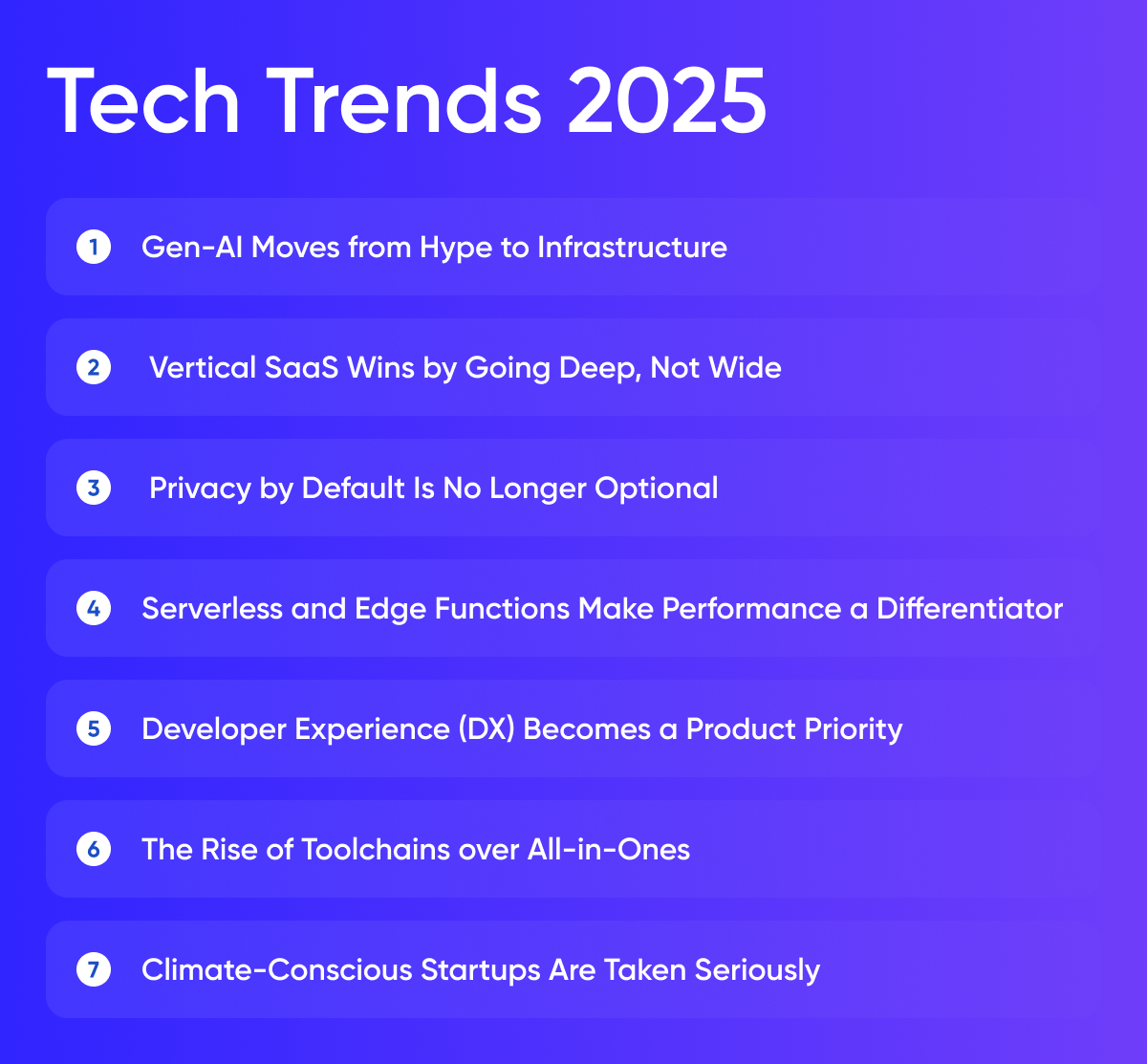Staying ahead of the curve isn’t optional for startup founders — it’s a survival strategy. As technology continues to evolve at breakneck speed, the landscape in 2025 is defined by tools and frameworks that weren’t mainstream even two years ago.
The good news? You don’t have to chase every trend. But you do need to understand which ones are shifting user expectations, developer workflows, and investor interest.
Here’s what we’re seeing at Movadex — from founders in the trenches, to product teams launching daily — and what it means for your next big move.

1. Gen-AI Moves from Hype to Infrastructure
We’re past the point of AI being just a novelty. In 2025, generative AI is an embedded layer across most SaaS products. It’s powering onboarding flows, contextual help, dynamic content generation, automated design drafts, and even early code suggestions.
OpenAI, Anthropic, Mistral, and open-source models like Mixtral are being used under the hood — but few apps advertise the backend anymore. The focus now is on useful UX. Founders need to ask: how does AI make my user faster, smarter, or more successful?
Pro tip: if you’re not building an “AI startup,” you can still be an “AI-powered product.” Users will care more about outcomes than the label.
2. Vertical SaaS Wins by Going Deep, Not Wide
The horizontal SaaS boom is maturing. Now, the edge lies in specificity.
Builders are creating tools laser-focused on industries like mental health, logistics, construction, and creator education — and embedding not just software, but workflows, integrations, and community.
If you’re a founder, this is a golden moment. Deep domain knowledge + lean product = unfair advantage. Investors are also paying closer attention to TAM with depth, not just breadth.
3. Privacy by Default Is No Longer Optional
Regulatory frameworks are catching up. In 2025, GDPR, CCPA, and upcoming global policies (India, Brazil, parts of Africa) make privacy and data ethics a competitive feature.
Founders must think from day one about data storage, consent flows, deletion requests, and user control.
Tooling is catching up: expect to see more out-of-the-box libraries for compliant auth, analytics, and user preference centers. But strategy matters too. How you handle privacy will impact customer trust — and your ability to expand globally.
4. Serverless and Edge Functions Make Performance a Differentiator
“Fast enough” is no longer good enough. With frameworks like Vercel Edge, Cloudflare Workers, and AWS Lambda evolving, apps are expected to load and react instantly, globally.
Startups are ditching traditional monoliths in favor of modular, serverless systems that scale dynamically and reduce ops costs.
The result? Faster deploys, easier rollbacks, and resilient infrastructure from day one — all without a huge DevOps team.
If you're building something that depends on responsiveness (think dashboards, collaborative tools, personalization), investing in serverless will likely pay off.
5. Developer Experience (DX) Becomes a Product Priority
The line between product and platform is blurring. For API-first companies, marketplaces, integrations, or internal platforms, developer experience is user experience.
Expect more attention to docs, playgrounds, SDKs, auth flows, and self-serve onboarding. Stripe, Twilio, and Supabase set the standard — now even small startups are expected to match that polish.
If you’re building anything developers will touch, invest early in clear docs, quickstarts, and thoughtful error handling. It’s not fluff. It’s retention.
6. The Rise of Toolchains over All-in-Ones
Teams are ditching monolith platforms and stitching together smaller tools tailored to their workflow. Whether it's internal dashboards, analytics, CRM, or product ops, modular toolchains are winning.
This shift means more demand for clean APIs, data portability, and services that play nicely with others. If your product isn’t interoperable, it’s probably not viable.
7. Climate-Conscious Startups Are Taken Seriously
Sustainability is no longer a niche. In 2025, carbon reporting tools, energy-efficient infrastructure, and climate-positive business models are becoming baseline.
Startups in fintech, logistics, agtech, and energy are embedding climate metrics into core functionality — and investors are watching.
Founders should consider their tech footprint, not just their marketing. Cloud providers now offer green deployment options. The way you build matters.
Final Thought: Don’t Follow Trends — Translate Them
It’s easy to chase trends. But the smartest founders don’t copy what’s hot — they translate it into value for their users.
AI, edge, privacy, sustainability — these aren’t fads. They’re the new surface area of competition.
At Movadex, we help startups adapt faster, build smarter, and stay relevant in an ecosystem that never stops shifting. If you’re planning to launch, pivot, or scale in 2025 — these are the forces shaping what’s next.
Don’t just read the trends. Build for them.




